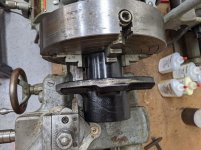Thanks for the super prompt and great answers to my question! I've been watching a couple of videos on trepanning and it looks like I would need to grind a custom cutter for the job which I've never done but think would be fun. However I'm concerned that the depth of cut might be too high which because flange is close to .625 or so just eye balling it.
LOL! "depth of cut too HIGH?"
Somewhere in PM's archives..." is a still YOUNG John Oder, overseeing a trepanning operation.. a tad over half-way down a 'normous length of solid steel round to make it into a
tube .. for drilling OIL WELLS. If that were not challenge enough? They then MET that half.. from the other end, and then... had a slug of steel good enough to make smaller goods from.
My modest collection of annular cutters presently stops at two-inch depth before it hits the slug.
Six-inch ones are stock items.
Maybe I should just go at it by reducing the diameter as mentioned by thermite.. I'm so new to the lathe that maybe thats the obvious answer for my situation. I'm only doing two wheel hubs anyways.
Just TWO?
No further pondering needed, then.
JFDI.
"Hardened?" Most everything is.
REAL question is "to what level of hardness, and how deeply?"
For wheel hub flanges, it will not be by enough to bother decent HSS cutting tools, nor trifle Carbides in the least if you run those.
Interrupted cut, OTOH, as initial passes may be, flanges not always being true "round", HS manages better.
One can also switch tooling, mid job.
We did that OFTEN to get past the worst of corncob stick-weld repair build-ups, some tasking best served by three different HSS flavours, and now and then carbide TOO!
First comes safe. Later comes fast.
Start cautious. Gentle cuts. Workholding has to be "right" lest you pop the work out of the chuck and into something it can harm.
If yah pay attention, the machine-tool, cutter, and workpiece sorta "talk" to yah, and it becomes more natural.




